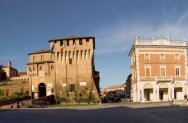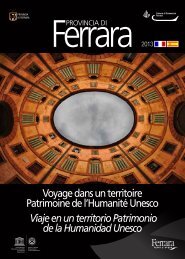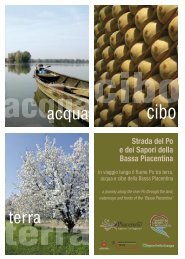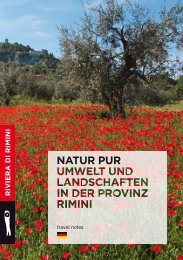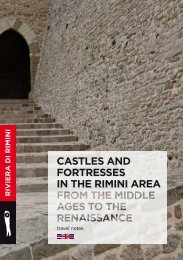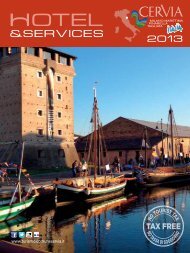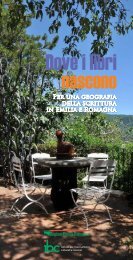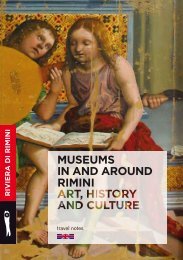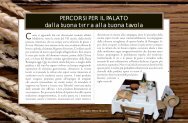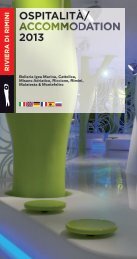Uppennino piacentino - Emilia Romagna Turismo
Uppennino piacentino - Emilia Romagna Turismo
Uppennino piacentino - Emilia Romagna Turismo
Create successful ePaper yourself
Turn your PDF publications into a flip-book with our unique Google optimized e-Paper software.
Strada del Po e dei sapori della bassa piacentina<br />
Nel territorio della provincia di Piacenza, tra le diverse realtà climatiche e morfologiche, si incontra la nebbiosa Bassa padana del grande<br />
fiume Po, dei suoi affluenti e dei pioppeti: è qui che nasciamo, attraversando i comuni rivieraschi del fiume Po con le tradizioni e le<br />
culture di cui il territorio è permeato. Il viaggiatore che percorre questo itinerario con l'intenzione di dedicarsi ad uno shopping goloso,<br />
rimane attratto dal forte senso di identità che si respira lungo tutto il percorso. Non solo castelli o paesi rivieraschi, non solo filari di<br />
pioppi lungo gli argini, ma un lento ed equilibrato immergersi in un insieme di tutto questo: ottimi salumi e formaggi degustati dopo<br />
aver visitato il castello e il centro storico, o aver percorso gli argini in bicicletta… Questo vogliamo esprimere: la storia, il territorio, le<br />
tradizioni, i sapori genuini. La nuova sensibilità con la quale il moderno turista-viaggiatore si accosta a realtà tradizionalmente diverse da<br />
quelle familiari, può trovare un percorso d'elezione lungo l'itinerario enogastronomico della bassa piacentina. Il tracciato, di una<br />
lunghezza di circa 80 chilometri, si sviluppa in modo circolare tra i paesi a ridosso degli ampi meandri del Po: Besenzone, Caorso,<br />
Castelvetro Piacentino, Cortemaggiore, Monticelli d'Ongina, San Pietro in Cerro e Villanova sull'Arda.<br />
Po river and dine route through the low piacenza plain<br />
In the area of Piacenza Province, among the different climatic and morphological realities, we meet the foggy low plain of the Po river<br />
with its tributary streams and poplar plantations: we were born here, crossing the coastal municipalities of the Po river with the<br />
traditions and cultures that all the territory is permeated with. The traveller who covers this itinerary with the intention of dedicating<br />
himself to a tempting shopping is attracted by the strong feeling of identity which one can breath along the route. Not only castles or<br />
coastal villages, nor rows of poplar trees along the embankments, but a slow and balanced dipping in a mix of all these things:<br />
excellent wrapping sausages and cheeses, tasted after visiting the castles and the historic city centre or riding along the<br />
embankments… We just would like to express this: history, territory, traditions, genuine tastes. The new sensitivity with whom the<br />
modern tourist-traveller approaches some realities - traditionally different from the familiar ones -, may find a special path along the<br />
food and dine itinerary of the low Piacenza plain. The about 80 kilometres route develops circularly along the villages behind the wide<br />
Po meanders: Besenzone, Caorso, Castelvetro Piacentino, Monticelli d'Ongina, San Pietro in Cerro e Villanova sull'Arda.<br />
Strada dei vini e dei sapori dei colli piacentini<br />
Una formella del 1330 conservata nel Museo Civico di Palazzo Farnese a Piacenza reca la seguente epigrafe in volgare: “Signori vu sie tuti<br />
gli benvegnù / e zascaun chi che vera sera ben / vegno e ben recevu” (Signori voi siete tutti qui benvenuti e ciascuno che qui verrà sarà<br />
benvenuto e ricevuto). Piacenza e la sua provincia rappresentano un territorio autentico dove hanno ampio spazio i valori del quieto<br />
vivere e dello svago, allietati da una cucina semplice ma gustosa e da vini di sicura e antica fama. Non solo castelli o borghi medievali, non<br />
solo antichi monasteri e splendide abbazie e nemmeno un veloce assaggio di qualche prodotto, ma un immergersi lento in tutto questo:<br />
una specialità assaporata lentamente con un bicchiere di vino locale dopo aver visitato una pieve romanica o una torre tardo romana,<br />
magari ricca di leggende e storie che si tramandano da anni e anni, insomma un insieme inscindibile di storia, territorio e tradizioni. Il<br />
percorso della Strada dei Vini e dei Colli Piacentini si sviluppa dai confini con le province di Pavia a nord-ovest, e Parma a sud-est, e<br />
attraversando trasversalmente la fascia collinare del territorio <strong>piacentino</strong>, incontriamo la Val Tidone, degli antichi sapori e castelli da<br />
fiaba, la Val Trebbia, dei paesaggi di luce e acqua, la Val Nure della natura incontaminata e la Val d'Arda di vigneti e suggestive erosioni<br />
collinari.<br />
Wine and dine route through the hills of piacenza<br />
A tile dated 1330 and preserved in the Museo Civico di Palazzo Farnese in Piacenza reports the following epigraph in the vulgar tongue:<br />
“Signori vu sie tuti gli benvegnù / e zascaun chi che vera sera ben / vegno e ben recevu” (Ladies and Gentlemen, you are all welcome here<br />
and everybody who comes will be welcomed and accommodated). Piacenza and its province represent an authentic territory where the<br />
values of the quiet living and amusement have large room, cheered by a simple but tasty food and by well known guaranteed wines. Not<br />
only medieval castles or villages, nor ancient monasteries and magnificent abbeys, nor a quick taste of some products, but a slow<br />
plunging into all this: a specialty tasted slowly with a glass of local wine after visiting a Romanic parish church or a late roman tower,<br />
maybe rich in legends and histories that have been handing on for years; in short, an inseparable whole of history, territory and<br />
traditions. The course of the Wine and Dine route through the hills of Piacenza develops from the boundaries between the Northwest<br />
ward province of Pavia, and the Southeast ward province of Parma, and crosses the hilly strip of the Piacenza area, where you can meet<br />
the Tidone Valley, with its ancient tastes and marvellous castles, the Trebbia Valley, with its light and water views, the Nure Valley, with<br />
its uncontaminated nature and the Arda Valley with its vineyards and attracting hilly erosions.<br />
<strong>Uppennino</strong> <strong>piacentino</strong><br />
unico naturalmente / naturally unique<br />
www.uppennino<strong>piacentino</strong>.com



